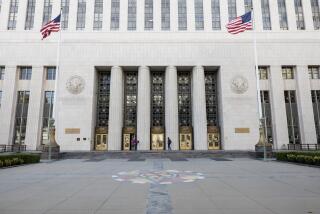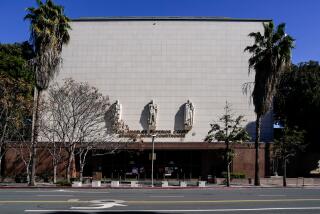Judicial myopia in Los Angeles
- Share via
There are judicial decisions you can ponder, others over which you argue, and some that just leave you shaking your head in slack-jawed wonder.
Los Angeles County Superior Court Judge Hilleri G. Merritt’s imposition of a prior restraint order on The Times falls squarely into the latter category. With the judge’s permission, one of the paper’s photographers shot pictures of a defendant charged with killing four people. Merritt then changed her mind and ordered the paper not to publish the images, despite the fact that the accused man’s photo already has appeared on television and been posted on the Internet.
The judge said she was concerned about issues surrounding the ability of eyewitnesses to identify a suspect in the case. Merritt said that although images of Alberd Tersargyan had been made public, pictures showing him wearing a prison jumpsuit in the cage-like lockup area of her courtroom could be more prejudicial to potential witnesses.
Merritt said that she believes the defendant’s 6th Amendment right to a fair trial requires the imposition of a prior restraint on The Times, because her “job is to balance many interests.... There are bells that cannot be unrung.”
The only bell ringing is the alarm set off by this judge’s heedless disregard for the entire history of 1st Amendment jurisprudence, an area in which not just journalists have a rooting interest. When the Founding Fathers spoke about freedom of the press, the prohibition of any prior restraint on speech or publication was precisely what they had in mind, because that’s how William Blackstone defined it in his celebrated commentaries on the common law. As the U.S. Supreme Court held in Nebraska Press Assn. vs. Stuart — a case directly involved allegations of conflicting 1st and 6th Amendment rights — “[P]rior restraints on speech and publication are the most serious and the least tolerable infringement on 1st Amendment rights.”
That’s why The Times is appealing Merritt’s unconstitutional order, and why the paper certainly will win. As Jeff Glasser, an attorney representing The Times, argued Thursday, neither the U.S. Supreme Court nor the California Court of Appeal has ever upheld a prior restraint.
You have to wonder how much of this whole abysmally wasteful exercise owes itself to the seldom-discussed transformation that California’s trial court bench has undergone over the last few decades. Until the 1980s, the state’s governors usually prided themselves on the breadth of their judicial appointments, which often included older attorneys with broad experience. Many major law firms noted with satisfaction their former partners’ presence on the bench. Then, two things occurred: An explosive growth in lawyers’ incomes turned the gap between a judge’s salary and what most successful attorneys could make into a yawning chasm; simultaneously, the get-tough-on-crime orthodoxy swept California politics, and experience as a prosecutor became almost a prerequisite for a judgeship. (As governor, Arnold Schwarzenegger has gone out of his way to restore a bit of balance to the bench, something for which he gets too little credit.)
The result of all this was that a judgeship simply became an upper rung on what amounted to the legal civil service. Merritt is virtually a poster child for this process. She’s a relatively inexperienced judge — elected in 2008 at age 39 — whose 14-year legal career was spent working as a deputy district attorney. As she told an interviewer at the time, she decided to run for an open judicial seat rather than seek gubernatorial appointment, which involves extensive screening and interviews, because she knew there were so many other, more experienced prosecutors in line ahead of her.
Merritt spent more on her campaign — $315,000, mainly for mailings and a professional consultant — than any other successful Los Angeles County judicial candidate that year. The bulk of her funds came as loans from herself and family members. In other words, she came to the bench on the basis of limited experience, unscrutinized by the usual appointment process and after an electoral process driven mainly by a direct-mail campaign, which was self-financed.
Yet here we all are, locked in a now-unavoidable struggle over the most fundamental of constitutional rights, one whose outcome is guaranteed but that will cost the taxpayers and everyone else involved precious funds desperately needed elsewhere. A black robe can conceal many faults, but not willful myopia.
More to Read
Sign up for Essential California
The most important California stories and recommendations in your inbox every morning.
You may occasionally receive promotional content from the Los Angeles Times.










